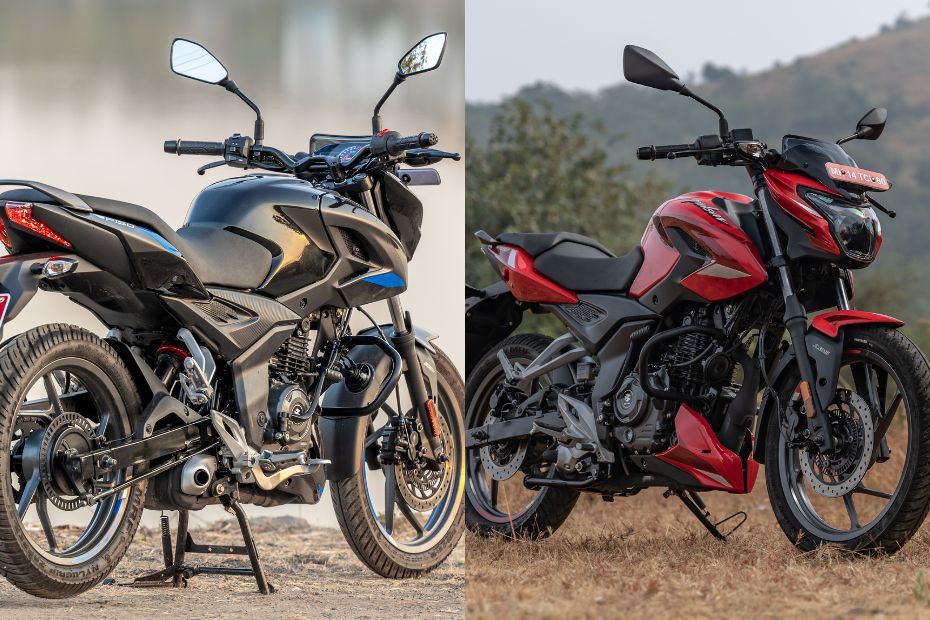Bajaj Pulsar P150 Single Disc vs Twin Disc: Real-world Mileage & Performance Explained
Modified On Mar 24, 2023 03:01 PM By Ishan Lee for Bajaj Pulsar P150
- 1851 Views
- Write a comment
We explore, which of the two variants makes the most sense and for whom

With the new P150 Bajaj is offering one bike in two different flavors. The single disc variant is aimed at people with more commuter needs, meanwhile the twin-disc variant is for the rider who wants something sportier.
Both bikes have minor but critical differences in ergonomics, braking hardware and tyre sizes which help them achieve their respective goals better. Here’s how both of them perform out in the real world across a bunch of tests.
Fuel Efficiency:
|
Variant |
City |
Highway |
|
Twin Disc |
49.7 kmpl |
48.8 kmpl |
|
Single Disc |
51.54 kmpl |
NA |
In terms of fuel efficiency, the Pulsar P150 Single Disc variant is the most frugal thanks to the minor weight advantage along with the thinner tyres. Since it offers two kilometers per litre more in the city than the Twin Disc variant, we are expecting its highway efficiency too to be slightly better.
Acceleration:

|
Variant |
0-60 kmph |
0-80 kmph |
0-100 kmph |
|
Twin Disc |
6.01 seconds |
10.91 seconds |
21.05 seconds |
|
Single Disc |
5.72 seconds |
10.18 seconds |
19.18 seconds |
Furthermore, with regards to outright acceleration, the Pulsar P150 Single Disc variant is the quickest thanks to the differences between the two models. While the data shows evidently that the difference between the two models isn’t much, the Single Disc variant does feel sprightlier.
Roll-on Acceleration:
|
Variant |
30-70 kmph in 3rd gear |
40-80 kmph in 4th gear |
|
Twin Disc |
6.52 seconds |
9.01 seconds |
|
Single Disc |
6.20 seconds |
8.59 seconds |
Even on the go, both bikes pick up speed effortlessly and without any fuss. But, being a commuter-focused engine, the pick up on 3rd and 4th gears do not feel urgent. There is a noticeable lag before the engine picks up the revs.
Tyre sizes:

|
Variant |
Front Tyre |
Rear Tyre |
|
Twin Disc |
90/90-17 |
110/80-17 |
|
Single Disc |
80/100-17 |
100/90-17 |
The difference in tyre sizes of the two P150 variants can be a deciding factor for the rider looking for a sportier ride. We aren’t saying that the single disc variant isn’t confidence-inspiring around corners, but wider tyres simply bring more confidence to push the bike faster. It even has a significant impact on braking.
Braking:
|
Variant |
80-0 kmph |
60-0 kmph |
|
Twin Disc |
36.20m |
20.40m |
|
Single Disc |
37.61m |
21.04m |
Considering that both these bikes will spend their lives as city dwellers undertaking occasional highway jaunts, the twin disc variant offers the most safety and hence makes the most sense to us. In the city, speeds are low but the frequency of emergency braking is more. The twin disc variant stops at a lesser distance and with more stability. That said, both bikes are equipped with single-channel ABS.
Verdict:

The choice here is simple. The Pulsar P150 Twin Disc is the one to choose if "sporty" from "sporty commuter" is the keyword for you. The P150 Single Disc, on the other hand, makes for a better daily motorcycle if "commuting" is your main concern. With the P150 single-disc costing Rs 1,16,755 and the P150 twin-disc setting you back by 1,19,757 (both ex-showroom Delhi), the margin is thankfully narrow.
